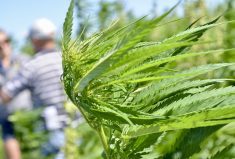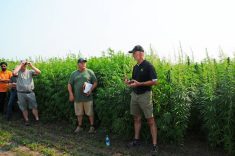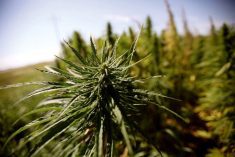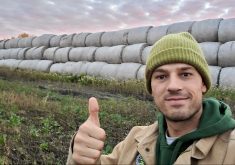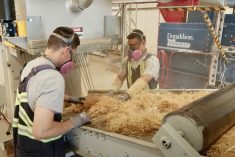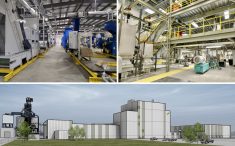You can’t get high with hemp, but your profit margins might get a lift if you choose to add it to your irrigated rotation.
And recent changes are making hemp even more attractive in Alberta, including a new hemp-processing facility slated for Nisku and a long-hoped-for easing of regulations by Health Canada.
“Up until last year, all hemp was carried to Manitoba where the major processors are,” said Jan Slaski, who wears many hats as senior researcher and team lead for crop development and management at InnoTech Alberta, a Crown economic development agency.
Read Also

Grazing ‘sweet spot’ boosts pasture performance
Timing-focused approach to pasture management touted to boost forage growth, livestock gains while also cutting farmer labour and inputs
“I’m pretty much positive 2017 will be a record-breaking year as far as (hemp) production is concerned.”
That optimism stems largely from the decision of Hempco Food and Fiber Inc. to build a new 56,000-square-foot grain- and fibre-processing facility at Nisku. The company is publicly traded, but the majority of shares are still owned by founders Charles and Angela Holmes. Hempco has been processing hemp seeds since 2008 and has a line of hemp-based foods, snacks and oil sold under the brand name PlanetHemp.
The company, which has oil presses in Saskatchewan along with hulling and milling facilities in Manitoba, is preparing for long-term growth with its Nisku facility, said CEO Charles Holmes.
It has contracted more than 10,000 acres this year, he said.
“That produces for us about 1,000 pounds per acre,” said Holmes. “So if you say 10,000 acres, that’s about 10 million pounds of product.”
But that is just this year’s goal.
“The facility we have has the capacity to do six times that,” he said. “That’s what our goal is over the next two to three years. We are building a facility that will be able to process any expansions in the industry, quick or slow, in the next two to five years.”
Less paperwork
After years of lobbying by the Hemp Canada Trade Alliance, Health Canada is relaxing regulations that have required growers to jump through hoops aimed at ensuring no one uses hemp production as a cover to grow marijuana, its soon-to-be decriminalized cousin.
In November, Health Canada made two significant changes. First, although seed growers will still have to test for THC levels (the psychoactive chemical in marijuana), commercial growers won’t have to for most hemp varieties. This not only saves costs, but also removes the risk of having to delay seeding while waiting for approval.
“Producers don’t have to wait until late June to put seeds in the ground if they want to plant in May,” said Slaski, who is also a director with the Hemp Canada Trade Alliance.
That can be key as agronomic studies by Farming Smarter found hemp can perform very differently, depending on seeding dates. The studies, all done on irrigated land, found there’s a sweet spot for seeding: Seed too early and you get tall plants (and lots of stalks and other residue to deal with later). But wait too long, and yields are reduced.
“When folks are targeting grain, they’re also seeding their hemp quite late — end of May beginning of June,” said Ken Coles, general manager of Farming Smarter. “They’re doing that so the crop doesn’t grow as tall and it doesn’t really impact the grain yield as much.”
And growing hemp under irrigation offers a major boost.
“Hemp can be grown on dryland and on irrigated land,” Slaski said. “You can get 30 to 40 per cent more grain yield on irrigated land.”
The other big Health Canada change gives producers field rotation flexibility — producers now only need to provide GPS co ordinates and legal land description of hemp fields after seeding rather than with the initial licence application.
Health Canada has also hired more people so it takes less time from application submission through to licensing.
Fibre potential
While grain is the big money-maker in hemp production right now, advocates of the crop have long touted the potential of fibre. Long fibre can be used for biocomposite materials and the core portion is used for biobuilding materials and animal bedding. Currently, InnoTech Alberta has the only decortication plant in North America, a pilot plant capable of processing one ton of straw per hour.
“A commercial facility would be seven to eight tons per hour input,” said Slaski.

Hempco’s Nisku facility will be approximately half fibre processing and half food processing.
There is some demand for InnoTech Alberta’s fibre in Alberta, although it’s limited. TTS – Sustainable Biocomposite Technologies processes ‘biofibres’ (such as wood, hemp, and straw) used to make mats, panels, and other products at its facility in Drayton Valley while Just Bio Fiber in Calgary is using biofibres for construction materials.
Some varieties are suitable for grain production while others produce both grain and fibre.
“Varieties like Finola that have very short stature and not a lot of biomass tend to be the preferred varieties (for grain) because (farmers) don’t have to deal with the huge amounts of biomass going through their combines,” Coles said. “X59 is a nice dual-purpose plant. It’s in between on biomass and still good on grain.”
The Canadian Hemp Trade Alliance is also working with Health Canada to access another part of the hemp plant as a revenue source.
“We’re talking about using flowers and leaves for extraction of bioactive compounds, specifically non-narcotic cannabinoids,” Slaski said. “The most popular non-narcotic cannabinoid is CBD. This is a great revenue stream because CBD sells for extremely high prices.”
Processed as an oil, CBD (short for cannabidiol) is touted to have health benefits, including as a treatment to control epileptic seizures.
Currently, CBD-rich chaff, leaves, and flower parts are left on the ground.
“However, we could have a chaff collector to collect this part of the plant and extract the non-narcotic cannabinoid for medical applications and pharmaceutical uses,” said Slaski.
Hempco is prepared for CBD processing.
“We’re leaving a small section there for doing CBD processing,” Holmes said. “As soon as the legislation changes, we can have that available to us.”
In the meantime, Hempco is installing fibre-processing machines and awaiting some rezoning to accommodate the food-processing portion.
“We will have 12 to 15 people there this summer,” said Holmes. “We’re moving our office out of Vancouver, shutting that down, and moving everything to Alberta. By the fall, we should be set up with at least 20 to 30 people working there.”
For this year, Hempco has filled all of its contracts of conventionally grown hemp, but is still looking for more organic acres.
“I can take almost all the organic acres that can be made out there,” Holmes said. “There’s lots of demand.”



